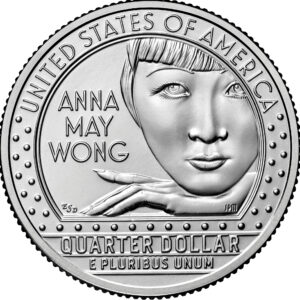May is Asian American Pacific Islander Heritage Month. To kick things off we’re highlighting the first Chinese American Actress, Anna May Wong.

Born as Wong Liu Tsong in Chinatown of Los Angeles, 1905 to Wong Sang-Sim and Lee Gon-toy. Her parents were second generation Americans and owned a laundromat. Anna’s parents first sent Anna and her older sister, Lew-ying to California Street School. The sisters were enrolled at the school for a short time. Anna’s parents pulled the girls out after the constant bullying and discrimination from the White students. Anna and her sister went to the Chinese Mission School in Chinatown. During the 1910s, film productions moved from the New York area to California. Anna quickly became curious about movies and started skipping school to go to sets and using her lunch money to go to the movie theater. When she was nine years old, Anna said that she wanted to be an actress much to her parent’s dismay. Anna changed her name to Anna May Wong to incorporate her American nickname and her Chinese name. At fourteen, Anna made her film debut in The Red Lantern, where she was an extra.
“I would worm my way through the crowd and get as close to the cameras as I dared. I’d stare and stare at these glamorous individuals, directors, cameramen, assistants, and actors in greasepaint”
In 1921, Anna dropped out of high school to pursue acting full time. She got her breakout role in The Toll of the Sea inspired by Madame Butterfly. The film was also the first full length feature film to be in technicolor. As her success grew, Anna found it more and more challenging to get bigger roles. Due to the lack of opportunities for her, Anna founded her own production company. However the company closed shortly after. American audiences at the time wanted to see Asian actors as stereotypes of either passive characters or Dragon Ladies. Also in the 1910s, many parts of the country had Anti-Miscegenation laws. These laws prohibited interracial couples from appearing and kissing on screens. This blocked the hopes of Anna being in a romantic movie. Another problem is Hollywood’s decision to cast non Asian actors in roles. This is called Yellowface, and Anna had to compete with white actresses to play asian roles. In spite of all of this Anna consistently showed that Asian women can have successful careers. Also in the 1900s, The Chinese Exclusion Act made people of Chinese descent carry around their identification card at all time.
“I was so tired of the parts I had to play. Why is it that the screen Chinese is nearly always the villain of the piece, and so cruel a villain—murderous, treacherous, a snake in the grass. We are not like that.”
Tired of the lack of mobility in Hollywood, Anna decided to go to Europe. In Berlin, Anna was starring in plays and films following other expats like Josephine Baker to have greater success outside of the United States. In Europe, Anna made seven films in English, French and German. She appeared in the operetta, Tschun Tschi as well as A Circle of Chalk with Laurence Olivier.

In 1930, Paramount Studios wanted Anna to come back to the States and promised her more leading roles. Anna made her Broadway debut in On the Spot. The movie, Daughter of the Dragon was the only time Anna shared the leading part with another Asian actor, Sessue Hayakawa. In November of the same year, Anna’s mother was struck and killed by a car in front of the family home in Chinatown. Anna’s family would stay in America for another four years before going back to China in 1934. Anna’s most well known film was released in 1932, The Shanghai Express. Even though Anna was also top billed, she was only paid $6,000 compared to Marlene Dietrich’s $78,000. In the latter 1930s, MGM was producing The Good Earth, the novel by Pearl Buck into a movie. Buck told the studio she wanted an all Chinese cast. Wong had several auditions but MGM cast white actor Paul Muni for the husband Anna’s chance was gone. Luise Rainer got the role and the Smithsonian wrote “To appear ‘more Asian,’ Rainer applied tape to the sides of her eyes. Wong openly criticized Hollywood casting.”
“There seems little for me in Hollywood, because rather than real Chinese, producers prefer Hungarians, Mexicans, American Indians for Chinese roles.”
In the 1950s, Anna was the first Asian American to lead her own tv show, The Gallery of Madame Liu-Tsong. Anna plays an art gallery owner and detective along the lines of Murder She Wrote. The show aired on the DuMont Channel and ran for ten episodes before the Network canceled it. The archival tapes of the DuMont Network are theorized to have been dumped in the Hudson River.
Anna died on February 3, 1961 of a heart attack. In 2022, The United States Mint issued a coin for the American Women Quarters and she is the first Asian American to be featured on US currency. The Quarter is a part of a series that honors the accomplishments of women in different fields. She appeared in more than 60 films over the course of her career.

Future Reading
https://www.oprahdaily.com/entertainment/tv-movies/a32345890/anna-may-wong-facts-real-story
https://wams.nyhistory.org/confidence-and-crises/jazz-age/anna-may-wong/#
https://content.time.com/time/arts/article/0,8599,1022536-3,00.html
www.nyhistory.org/blogs/anna-may-wong-americas-first-chinese-american-starhttps://
www.pbs.org/wnet/americanmasters/anna-may-wong-first-asian-american-movie-star-bfnigk/13978/
https://www.history.com/news/anna-may-wong-facts-career
https://www.womenshistory.org/education-resources/biographies/anna-may-wong


Recent Comments